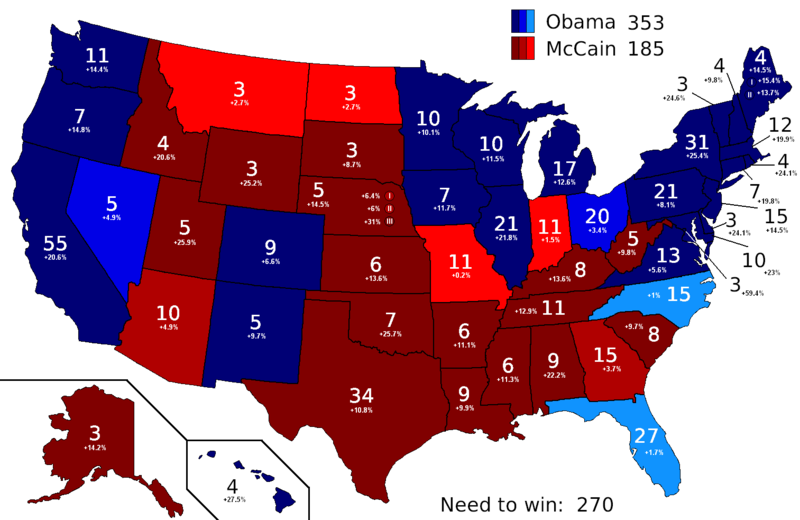How does the Electoral College Work?
November 12, 2020
As President Trump files lawsuits in key battleground states, The Gator thought to offer some insight into the United States Electoral College, how it works, and whether your vote actually counts.
What is the electoral college?
To begin, the electoral college is not a college that students go to become President, but rather a system in which the United States chooses its President. However, the citizens of the United States do not directly vote for a candidate. Instead, a group of people, called electors, cast votes on behalf of the people. There are 538 electors that meet and casts their vote for their state.
The electoral college first appeared in Article 2, Section 1 of the Constitution, stating, “Each State shall appoint, in such Manner as the Legislature thereof may direct, a Number of Electors, equal to the whole Number of Senators and Representatives to which the State may be entitled in the Congress: but no Senator or Representative, or Person holding an Office of Trust or Profit under the United States, shall be appointed an Elector.”
The 12th Amendment, ratified in 1792, clarified the purpose of the electoral college. “The Electors shall meet in their respective states and vote by ballot for President and Vice-President, one of whom, at least, shall not be an inhabitant of the same state with themselves; they shall name in their ballots the person voted for as President, and in distinct ballots the person voted for as Vice-President,” it reads.
Who are electors and how are they chosen?
Behind each of the 538 electoral votes in the electoral college is a representative who casts a vote on behalf of citizens. This representative is called an elector. Article 2, Section 1, Clause 2 of the Constitution states that individuals already in certain government positions are not eligible to be electors—mainly Senators and House Representatives. The 14th Amendment further clarified that electors cannot be someone who has “engaged in insurrection or rebellion against the United States, or given aid or comfort to its enemies.” The method by which electors are chosen varies by state due to varied policies on how electoral votes are distributed. In most states, electors are selected by each political party ahead of the election, and whichever party receives the majority of the votes puts forth the electors.
What is the difference between red and blue states?
On election night, you might have seen a map with states filled in either red or blue. Red and blue states refer to each party—Republicans in red, and Democrats in blue. If a state is shown in one of these colors, that means that candidate won the state’s popular vote.
How does one win the electoral college?
To win the election, a candidate must win over 270 electoral votes from any combination of the states. Additionally, it is possible for a candidate to win the electoral college without winning the popular vote—as seen in the 2016 election.
What happens if there is a tie?
According to 270toWin, if the presidential race is tied at 269 electoral votes, the House of Representatives selects the president and the Senate would choose the Vice President. In the House, each state gets one vote, and 26 votes are needed to determine the president. In the Senate, each senator gets a vote and a majority of 51 votes is needed for the Vice President to be elected.
What happens if an elector goes against its state?
This is what is called a “faithless elector.” Some states have penalties for electors that go against what people in the state want. For example, faithless electors in Oklahoma can pay up to $1000 in fines for their choice. Alternatively, Florida has no penalty. An important disclaimer is that no election has been decided on a faithless elector yet. However, in 2016, a record seven electors were faithless to their state.
How do states get assigned a number of votes? Which state has the most? The least?
The number of electors and electoral votes each state receives is based on the state’s population. The formula in Article 2, Section 1 of the Constitution states the number of representatives plus the number of senators—each state has 2—in each state is the number of electoral votes the state receives. In California, the state with the most electoral votes, there are 53 representatives and 2 senators, totaling 55 electors and votes they cast. In Wyoming, there is one representative and two senators, giving the state 3 electoral votes. In total, there are 100 senators and 435 representatives. That comes out to 535, and there are 538 electoral votes in the election.
The 23rd Amendment granted the District of Columbia three votes, even though the district does not have senators or representatives. The number of electors can change after the census is taken every ten years. For example, the state of Arizona will gain an electoral vote in 2024 to up its total to 12. The four states with the most electoral votes are California (55), Texas (38), Florida (29), and New York (29). There are many states that only have 3 votes, including North Dakota, South Dakota, Vermont, Montana, Wyoming, Delaware, and Alaska.
Why do Maine and Nebraska split votes?
Almost all the states vote by popular vote, however, Maine and Nebraska do not. These states vote by an at-large district worth two electoral votes, plus the remaining congressional districts (Nebraska with 3, Maine with 2). This allows votes to be cast for different candidates in these states. Some argue this is a more accurate way of how a state votes.
So, does my vote count?
Yes! A single vote can swing a state. If a state is divided 300,000-300,001, your vote could be the one that swings the state. Remember, it is important to vote. While the deadline for this year’s election has passed, there will be more elections in the future.























































